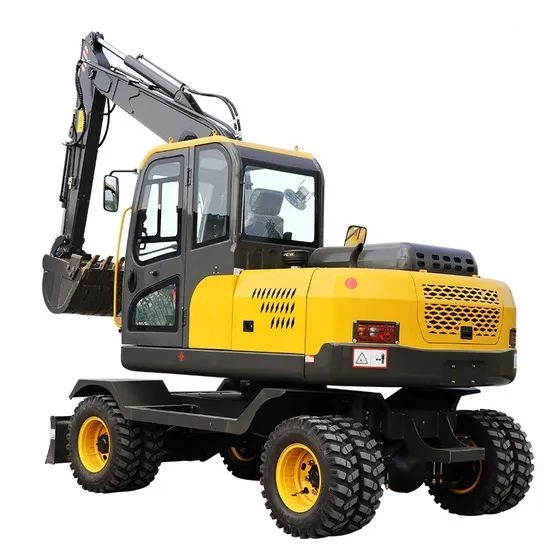- Working Environment: Terrain Determines the Core Choice

- Wheel Excavators:
Their advantages lie on hardened roads or solid ground (such as highways, factory areas, and urban streets).
With small tire contact area and high ground pressure (approximately 0.3-0.6MPa), they are prone to getting stuck and have poor stability on muddy or soft ground (such as farmland, wetlands, and mines).
Suitable for: Municipal maintenance (e.g., digging drainage ditches, breaking road surfaces), short-distance highway operations, and on-site transfers (without frequent off-roading). - Crawler Excavators:
Their advantages lie in complex terrains (muddy areas, mountains, swamps, and mines).
With large crawler contact area and low ground pressure (approximately 0.05-0.15MPa), they are not easy to get stuck and have extremely strong stability during operations (especially when heavy-duty excavation is performed).
Suitable for: Large earthwork projects (e.g., site leveling, foundation pit excavation), mine stripping, farmland reconstruction, wetland/mountain operations, and other scenarios requiring "off-road capability".
- Mobility and Relocation: A Trade-off Between Efficiency and Cost
- Wheel Excavators:
They have a fast moving speed (road speed can reach 20-40km/h) and can directly go on the road (some need to go through formalities for low-speed vehicles). Short-distance relocation does not require a trailer, saving transportation costs and time.
Disadvantage: For long-distance relocation (e.g., cross-city), a trailer is still needed (tires wear quickly, and long-distance driving is unsafe). - Crawler Excavators:
They have an extremely slow moving speed (usually ≤5km/h), and their crawlers will severely damage hardened roads (e.g., cracking highways). They must rely on trailers for relocation, resulting in high relocation costs (additional trailer fees and transportation time are required).
Suitable for: Long-term operations at fixed sites (e.g., mines, large construction sites) without frequent movement.
- Operation Intensity: For Heavy-load Needs, Choose Crawlers
- Wheel Excavators:
Tires have limited load-bearing and impact resistance capabilities. Their digging force is relatively weak (10%-20% lower than that of crawler excavators of the same tonnage), and the body is prone to shaking during operations, making them unsuitable for heavy-load operations (e.g., breaking hard rocks, lifting heavy objects).
Their tonnage is usually small (mostly 6-20 tons), and wheel excavators over 20 tons are extremely rare (due to the load limit of tires). - Crawler Excavators:
Crawlers provide stable support and stronger digging force (superior to wheel excavators of the same tonnage). They can be matched with larger buckets and breakers, making them suitable for high-intensity operations (e.g., mine stripping, large earthwork excavation, lifting steel components).
They cover a wide range of tonnages (1-100+ tons), and crawler excavators are almost the first choice for heavy-duty projects.
- Maintenance and Cost: Hidden Differences in Long-term Use
- Wheel Excavators:
Maintenance is simpler: Components such as tires and wheel reducers have structures that are easier to maintain than crawler tracks. Daily maintenance only requires checking tire pressure and bearing wear, with low maintenance costs (annual maintenance costs are approximately 60%-70% of those of crawler excavators).
However, tires wear quickly: If operating frequently on rough roads (e.g., gravel ground), the service life of tires may be only 2000-3000 hours, and replacement costs are high (a single tire costs from thousands to tens of thousands of yuan). - Crawler Excavators:
Maintenance is more complex: Crawler tracks (track shoes, bushings, driving wheels) are wearing parts, which wear extremely quickly when operating on muddy or gravel ground. Regular adjustment of tension and replacement of lubricating grease are required, resulting in higher annual maintenance costs (especially in heavy-load scenarios, which may be 1.5-2 times that of wheel excavators).
But crawlers have a longer service life: Under normal working conditions, crawlers can be used for 5000-8000 hours, and even in extreme environments (e.g., mines), they can reach more than 3000 hours.
- Regulations and Restrictions: Road Access Rights Affect Flexibility
- Wheel Excavators: In most areas, "low-speed engineering machinery licenses" can be applied for, allowing short-distance driving on roads (speed limits must be observed, usually ≤30km/h). They are suitable for cross-regional operations in cities (e.g., from section A to section B without a trailer).
- Crawler Excavators: They are almost not allowed to drive on roads (crawlers will damage road surfaces) and must be transported by flatbed trailers. Additional coordination of transportation permits is required for relocation across construction sites, resulting in low flexibility.
Summary: How to Choose?
Choose wheel excavators if the operation site is mainly on hardened roads, frequent short-distance movement is needed, and the operation intensity is low (e.g., minor municipal repairs, on-site transfers).
Choose wheel excavators if the operation site is mainly on hardened roads, frequent short-distance movement is needed, and the operation intensity is low (e.g., minor municipal repairs, on-site transfers).
Choose crawler excavators if the operation terrain is complex (muddy, mountainous), heavy-load excavation is required, or long-term operations at fixed sites are needed (e.g., large projects, mines).
In simple terms: "If you need to move a lot and the roads are good, choose wheel excavators; if you need to dig heavily and the roads are bad, choose crawler excavators."





